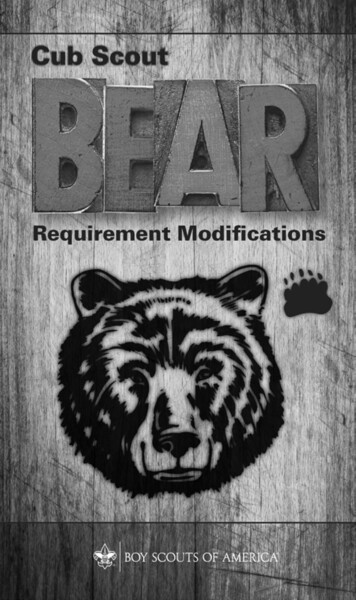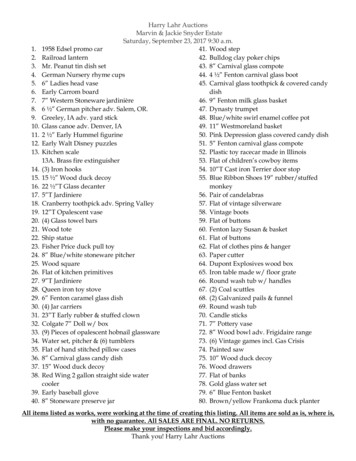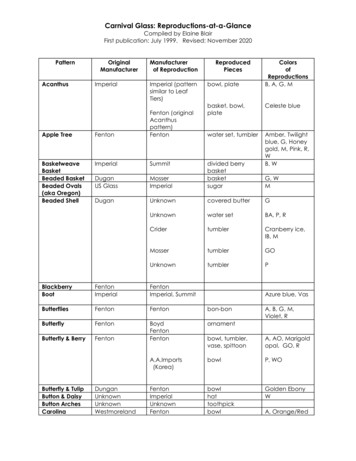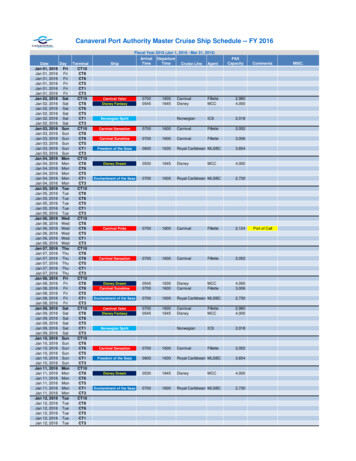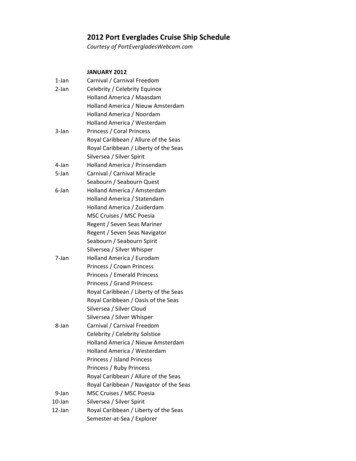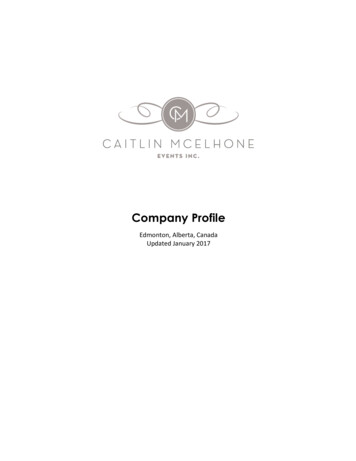
Transcription
CARNIVAL AND E OSTMODERNISM IN ATWOOD'S THE HANDHAID'S TALE
THEHANDMAIP'S :MARGARET ATWOOD'SUSE OFCARNIVAL AND THE POSTMODERNByELSIE MERLE PAGET, B.A., M.A.(French)A thesisSubmitted to the School of Graduate Studiesin Partial Fulfilment of the Requirementsfor the DegreeMastel: of ArtsMcMaster UniversityOctober 1990(c) Copyright by Elsie Merle Paget, October 1990
MASTER OF ARTS (1990)(English)McMASTER UNIVERSITYHamilton, OntarioTITLE:The Handmaid's Tale:MargaretCarnival and the PostmodernAUTHOR:Elsie Merle Paget,SUPERVISOR:B.A. (McMaster University)M.A. (French) (McMasterUniversity)Professor Ronald GranofskyNUMBER OF PAGES:Atwood's Usev, 123iiof
ABSTRACTThis thesis examinesl-fargaret Atwood's novel TheHandmaid's Tale with the purpose of showing that her combibation of carn valesque and postmodern writing enhances thereader's understanding of the social bonds between people ofunequal power (authority).The use of the narrator/iconthat relates to an oral culture and the juxtaposition ofvarious scenarios in which women participate highlight thesources of power that particularly affect women.The introduction establishes the tale as a fantasywhose grotesque realism is rooted in medieval carnival.Chapter I describes the literary devices of carnival as theyapply to The Handmaid's Tale.Chapter II focuses on thepolyphonic na rator/icon and the chanson de geste form ofthe tale.Chapter I I part (b) discusses the postmoderntechnique which allows inclusion of the historical materialthat relates palst and pres,ent.iii
ACKNOWLEDGEMENTSMy sincere thanks to Professor Ronald Granofsky for hispatient direct ton and his wise counsel in the preparation ofthis work.Thanks also to my husband Stan, not only for hispatience but for sharing his considerable knowledge ofhistory and politics.iv
TABLE OF CONTENTS1IntroductionChapter One16Chapter Two (Part A)49Chapter Two (Part B)82Conclusion106Notes119Works Cited121v
Introduction111"1-TheTheTheAndgood want powe , but to weep barren tears.powerful goodness want: worse need for them.wise want love; and those who love want wisdom;all best things are thus confused to i l l .1Shelley-----The desire for power overpne's self or over others \, ,.,. -".', . ,,'. .h ". . .· " · · ·· · . · -. .is always a dominant factor in the structure of any raphaf power andill whenonenote thefacetThe relationshipprecedence.abovethatbetweensince earliest times.writer isexception.innovative techniqueGlencomplexitythe individualDeersuggestsof the experimentalof unequal powerthattechniqueisthenovelist enhancesbonds(i.e. authority)"(Deer 2).Among the works Deer chooses to support his thesiswriter'sandThe twentieth-centurythe reader's ability to gain insight "into the socialbetween peopletakeshas fascinated playwrightsand novelistsnotheresulting confusion ofofsocial authority is a theme thatillustrateinstrumentalinthat therevealingthisrelationship is Margaret Atwood's novel The Handmaid's Tale.In this study I propose to show that Atwood's innovative useof carnivalesque writingdoes indeedabilityinto theto gain insightindividual andreader'srelationship between thesocial authority; thatlights the sources of power thatenhance thethis technique high-particularly affect women;and further, that The Handmaid's Tale does not adhere to anytraditional structure of thenovel but is experimental1and
2postmodern in its form.TheSLLf fereI1 ., 1!:Yit. thanpresently know.wi th al ienthetransports theone we,Yet the novel doesqJ{hJ ,an areaof thereader \.be ings.United statesTheButwithculture.It isfuture,2195.whichcoincidentala culture set beyondone thatInhas flourished andplace ofthe democraticNorth Americansof thepresentus, some time indied beforethethe yearwithpresently familiar,Gilead, an Abasedpuritanical.,. .fundamentalism,. . . on. . .-- .-.-.--. .----. .------------------------ '.---,Numerous;especiallytheuse'Gilead', evoke a Christian or.--------otherAmer icans.power structure,those in the mostallusions tothatTheareauthoritarian state---------------references,terrainof America.human, might beis nota . . . !:!2 ;.t.l} . ",, m,e l.g.§:Jls,inhabi tants, qu.i te recognizablytimetonot trouble the readeror incredibl geographyresemblesTal Handmaid'softhebiblicalbiblicalwordCalvinist fundamentalism butworld religionssuggest thatGilead'sfundamentalism could be Islamic, Hebraic, or even Buddhisticin origin.Recounted by a female narrator, the story focuses onthe handmaids.These are womentheir potentialabilityto bearselected by thechildren atstate fora timewheninfertility is high and live births have reached dangerouslylowlevels.
3that recalls the biblical lines in Genesis which Atwood usesas an epigraph for her book:And when Rachel saw that she bore Jacob no children,Rachel envied her sister; and said unto Jacob, Give mechildren, or else I die.And Jacob's anger was kindled against Rachel; andhe said, m I in God's stead, who hath withheldfrom thee the fruit of the womb?And she said, Behold my maid Bilhah, go inunto her; and she shall bear upon my knees,that I may also have children by her.(30:1-3)The phrasecurious onethatand doesRachelBilhah.Jacob'shemightactuallyhaveintends tochildrenacquire the childthe property ofthisait isby hermaid,no doubt as to howshe sodesires.SheChown the child sired bymaster oristhe instruction that(Bilhah), leavesin biblical times, the maid, asmy knees'describe howHowever, the previous phrase,will take as herwithuponnot specifically'go in unto her'Rachelshall bearher husband since,well as any issue, would bemistress.biblical precedent,theThus, inaccordanceCommanderattempts toimpregnate thehandmaid while she lies at the knees of the. "r.,., . .Commander's wife. /The handmaid has only a two year period.jin which to become regnant.--.---.--"-.--. . 'If she does not, sheassigned to the household of another" -.".'.anew period o ." . . :.If.". ",",',"'.-"-.Commander and allottedattempts to become,------------------". ,-""-- - - " ' " ' ' ' 'threedifferentCommandersallfail,thedeclared an "Unwoman" and sent to the Colonies. "will be'--pregnant by,.--""'''-.hatndmaidisHere, along'----------with other old, unfit or unwanted women, she is . assignedto.,.'''-. . . .,.,---.-.' ''': ---',.-. , . ""Q.ickinguprad ti ve 'j f!.;.1( tfwasj:.e.,. 1-i-t.e-r.a 1.J.y.r. e.le.g t:ed. to the
4trash heap.It isthroughhandmaid whoknowthetheofe}culture,has known a previo.state ofOffred,Thi ead.thenarratorthat we come tomythicalname, meaning"hard, uneven ground" is mentionedGenesis 31: 21,23,25,as well as in various other books of saidtobecountryaTransjorint ? namecan138).Atwood's """ .useof the."" .,.-'''. .;:,.,. . . ". ,"". ",.'- ", :.'"place butone wemaynamethussuggests.,."" . . . ". ,.". . . '-., . .,, : .,. , , ,.,. .,.'. e cou t r,allterritory,,' ',' -.",,,,.''t. -,," ("., .M.".,,,,,,., " .,. . , . ',"' '" .'. . """""'c:",:r""::'!" "c-' "- .J' 'C(I trough, as in the Gilead she ptrdys.- . . ."theia, "the differ"(Odelain and "-- '" While it is . .,.: , . " "",.A."'.tbei .ndi,.,",.,.,cat. c:i.,.1?x' I, I-/{hl-.Bible.""" "-' '"'W' no specific', .","··"''''' ""·''·'',·''.,·- ,''.,,,.·''"'' ·--· .;.Awhere thegoingisIt is the telling of1\ handmaid's experiences"'!Jtrange-1,;"".1«'\ ;/,\; ;:. .\"" " :" -:h.l't of femibih0 and 1 :t.1v.).t .,. in ilead that evokes a wholelL ''J./t,.j '"'1.,. . ' "i'\ ':, vecological issues,pertihent to andVl\\ k -t. '1))6'1prevcfIent in, the present culture.(VI n1, ' ,iCrt"" I '''1t ' , Allusions to jobloss,-- --.lackto persona.l E !l9.s orof accessdivorce,and -,childbirthsuch""' .-." . . . raise. . .''' ''' - -- "". --'''' . t !Il!nj.)?t.marJ::. ge,iss-ue-s-. ."g, ,"',. "equalityin·.thet: chnologyand the right to controlAllusionstohigh d.uc !?rl'education,workplace I'technology,reproductiveone's personal destiny.nature,thescarcityordisappearance of plant and animal life and deformed foetusessuggest the ecological issues with which the present culturemust now deal.powerthat tio tlAtwood exposes, in a novel way, the lines ofpermeateshe .---.-makes t \\,thesetheall iand'es and di lemmas thatscale.:{:':\1t .· .V '" .;. ",.,Thework isissues.reader fo/\.U ing) ) 1.t Jj ware. --UL ging anof. connections,. . . --.exist for women on ·t- ·a universalnor revolutionary,t1&
5yet, throughher particularuse ofI-' 1.%. 'IJirlI v": ; 0/ \. 'I"carnivalesque writing,. ., ---"" ."".'''' .-- .----' . .'"-the author produces a cautIonary tale.As do most critics, Glen DeerTaleas "dystopian."contrast tosignifiesR.W."utopian,"labels The Handmaid'sChambers pointsa termwhich in"something visionary-----outthat, inthe modernsenseand unpractical . aneasy-going paradise, whose only fault is that it is too happy andideal tobe realized"(149),"dystopian" connotesutopia, a bad or unlucky place.an anti-Ironically, even Sir ThomasMore's famous w0rk Utopia is, bythese standards dystopian,since it is a place where "few of us would feel quite happy"(149).Itdepictsstate"(l49)as doesa"sternlyrighteousAtwood's noveland puritanicalabout Gilead,a placewhose borders, like the biblical Gilead, are unknown.A dystopianJamesDeCylinder.Mille's AWrittenseveral features innovel within the CanadianStrange Manuscriptin thetradition isFound ina Coppermid-nineteenth century,common with The Handmaid'sit hasTale.Bothnovels are, of course, printed texts, but each is a narratedmonologue andhas adistinctly oralcomponent.In each,nature "less terrible than man"(De Mille 37) is something tobecherished, not conquered.and darkness,There are allusions to nightto knowledge and to thehistoric past.Bothnovels exude a satiric wit and both end abruptly. De Mille'sstory returns to his own time frame; Atwood's tale ends withan imagined future time.
6Both Glen Deer and Amin Malak compare ThsLHandmaid'sTale to other twentieth-century works such as Zaml'atin's We,Huxley's Brave {\fewdistiriguishWorld, and Orwell'sAtwood's novel fromUti.Inthese classicsorder towithin thedystopian tradition, Malak articulates sgme Of, tJ:le:ir salient \ ,II\, ., . : .' Ji(lfeatures.He notes that "dystopias essentially deal withpower:,.-----.power as-. --. ., . . ,. ".,potential;the prohibitionor permissionof human.,,-,power inits absoluteform"(lO).T'hey revealconflicts that arise for the individual when confronted withany of a long list of binary oppositions such ,as ,I!lotioncreative imagination and logic, love and power, goodr son,and evil, which Malak terms dialectical dualities(lO).maytake the formDystopianof dream-nightmare,characterstendsocieties in which theytheandfuture" (11).to befantasy or reality.two-dimensionaland theexist are associated "with ias, Malak suggests, fall into the category of a Romanatheseand thusdystopianironyfactcarrya message.features, Malakand feminismascribesto The Handmaid'sthat Atwood presents a societytechnologythat existssome twoBeyondthese basicthe addedelements ofwith a highly advancedhundred yearspresent, many critics see it as futuristic. 2those, likeBased on theTale.Butbeyond thethere areMa1ak, who also note its resemblance to sciencefiction or fantasy.3The novelclearly evinces traitsfantasy as well as elements of grotesque realism.of
7Rosemary Jackson defines fantasy as a literary mode.While she acknowledgesa debt to TzvetanTodorov who seeksto discover a pattern, "a principle operative in a number oftextsrather(Todorovthan what3),shethe fantastictomode, aromancescienceKafka)eachmainlya genre.broaderfictiom),She suggestsmoreinclusiveMode, inthis casethat takesE rolm these forms stem sUlchorthemarvellousfantastic literature"relatedof them"structuralmode, resembles language (langue)literatureandhiswhich genre develops.var ious ---forms (paroles).aswithto fantasy asbelongscategory out ofspecific aboutdisagreesanalysis that pointsthat fantasyIstalesofdelusion,hallucination, etc . "(7).aestheticelements hicstates,Themetaphysical anddistinguish suchindividual worksTodorov regards merely as organic characteristics.Jackson,on the other hand, sees the need "to consider the social andpolitical implicationsofthat, likeliterary fantasywithin, andanytext,literary forms"(6).determined by, itsWilliam Irwin's definition:and controlled byaccepted astransformingtheis thecondition contraryitself" (quoted in Jackson 14).of what isnarrativetofactfromShe cites"A fantasy is a storyitnotesproducedsocial context.an overt violationpossibility;isShebased ongenerallyresultofinto 'fact'This definition of fantasywhich coincides with Malak's notion ofdystopian fantasy is
8one appliedthecautions that,here'11\0-,,,,,towhile the violation ofinherent in this definitionconventionsitselfHandmaid's Tale.t.J.U"ta enJacksondominant assumptionsthreatens to subvert rulesandto be normative, such violation "is not ina sociallysubversive activity . Itdisturb 'rules' ofdoes, however,artistic representation and l1terature'sreproduction of the real"(14).Sherecalls that Dostoevskysaw fantastic literature as the "only appropriate medium entorigins"(17).Jacksonthat fantasy, whichofalsoalienationnotesSartre'smanifested humantranscend the hUman, fulfilled an escapistlong as religious faith prevailed.frompower tofunction only asBut in the "secularized,materialistic worldof modern capitalism", fantasy serves adifferent function.Althoughit retains its function asapressure against hierarchical systems,it does not invent supernatural regions, but itpresents a natural world inverted into somethingstrange, something 'other'.It becomes domesticated,hu anized,turningfrom transcendentalexplorationstotranscriptions ofahumancondition. (Jackson 17)This is surelywhereofthe fantasyworld ofThe Handmaid'sTale,we find the natural world inverted, the strange worldGileadthatsomething "other."transcribesthehumanconditionintoWith the opening words "We slept" and byentitling the first chapter"Night," Atwood sets thefor apoint ofdream fantasy.Theentryis thegymnasium, an area familiar in one way or anotherstageschoolto almost
9any reader.The setting evokes thoughts and imagesnarrator.imagesInturn,the narrator'sevokes for the readerprojectiona similar timefor theofthoseof life.Theimages are wide ranging and suggest progressive generationalchange aswellas variousreader, like thein akind ofWhilenarrator and thecarnivalclearly markingfantasy, Atwoodthe narratorshortfirstof lifesituations.Thuswhich thethe boundariesnoveliscomplete,reveals.between realityinto the world of fantasy.chapterthespectators, participatessimultaneously draws her readerdifference betweenbodies.socialandalong withAgain, before theshereality and fantasy:reinforcesthe"We still have ourThat was our fantasy"(14).Fantasy,carnival art(95).Jacksonnotes,Its roots arecanbetracedfound in thebacktomenippea, atraditional form of fantastic art, characterized by the samesubversive function which, as indicated above, "disturbs therules of artistic representation" in literaryfantasy.menippea allowed movement between this world, anand an upperworld; it combinedTheunderworldpast, present and future andoften contained states of hallucination, eccentric behaviouror other extraordinary situations.Bakhtin's definitions of thesimilarandfeatures in theothers to introduceJackson says:Jackson draws on Mikhailmenippea and his discoveryworks ofofRabelais, Swift, Sterne,the qualitiesof fantastic texts.
10Bakhtin points towardfantasy's hostility tostatic discrete units, to its juxtaposition ofincompatible elementsand itsresistance tofixity.Spatial,temporal and philosophicalordering systems all dissolve; unified notions ofcharacter are broken; language and syntax becomeincoherent.Through its'misrule',it permits'ultimate questions'about socialorder, ormetaphysical riddles as to life's purpose. Unableto give affirmation to a closed unified,oromniscient vision, the menippea violates socialpropriety. It tells of descents into underworldsof brothels, prisons, orgies, graves; it has nofear of the criminal, erotic, mad, or dead.(1S)All of these menippeanembodied in theconcepts are, according torituals of carnival.Bakhtin,In Rabelaisand HisWorld Bakhtin c0ntends that carnival is a "world inside out"(a l'envers) a topsy-turvy world that celebrates a temporaryliberation from established order(ll).Similarly, the grotesque realism evident in Atwood.snovel has itsr.oots in carnival.Bakhtin pointsthe material bodily principle withand,"it 1i;\\V Jl y «:- .-images of the human bodyfood, drinkJ defecation, and6'.'. . .p·redominant. . 5?!.e." .Jn. .the workout thatsexual life, plays a.of Rabelais. --------.(Rabelais 18).For this, Rabelais has been accused of "gross khtin explains,or "naturalism."ofwork arethismaterialthe heritagehumour expressed in the MiddleandTheyspectacle.imagery . thatofofsharplythethisprinciplethe cultureinof folkthrough carnival ritual"thatpeculiarcharacteristicfromarel g
11ages"(Rabelais 18)."grotesqueThis aesthetic conceptrealism."Itsdegradation, "the lowering ofBakhtin labelsessentialprincipleall that is high,spiritual,ideal, abstract; it is a transfer to the materialthesphereofearthandbodyintheirislevel, toindissolubleunity"(Rabelais 19).Bakhtin thus concludes thattheMiddle Agesare "nothingmany Latin parodiesbut aselection ofdegrading, earthy details taken from theand other sacredformstexts."Parody,of grotesque realismdepictsthe earth as an(the grave,laughter, and allotherdown to earth,This process of degradationelement that "devours, swallows upthe womb) andbirth, renascenceall theBible, the Gospels"degrade, bringturn their subject into flesh."ofat the same(the maternaltime an elementofbreasts)"(Rabelais 20,21).It concerns itself withthe lower stratum of the body, the life of thebelly and the reproductive or ans;it thereforerelates to acts of defecation and copulation,conception, pregnancy and birth; it has not only adestructivenegativeaspect,butalsoaregenerating one . Grotesque realism knowsnoother lower level; it is the fruitful earth andthe womb.It is always conceiving. (Rabelais 21)The regenerating,makes medievalambivalentaspect ofparody unique, notformalist literarysolelynegativeparodyfromparodyofat all likemodern times,character" (RabelaisAtwood'sgrotesquenovel reveals21).therealismthe "purelywhichThesamehasafollowingambivalentaspect of grotesque realism found in medieval parody:
12The Commander's Wife hurries in, in her ridiculouswhit cotton nightgown,her spindly legs stickingout benea h it.Two of the Wives in their bluedresses and veils hold her by the arms, as if sheneeds it; she has a tight little smile on herface, like a hostess at a party she'd rather notbe giving.She must know what we think of her.She scrambles onto the Birthing Stool, sits on theseat behind and above Janine, so that Janine isframed by her: her skinny legs come down on eitherside, like the arms of an eccentric chair. Oddlyenough, sh 's wearing white cotton socks, and bedroom slippers, blue ones made of fuzzy material,like toilet-seat covers. But we pay no attentionto the Wife, we hardly even see her, our eyes areon Janine.In the dim light,in her white gown,she glows- 1 ike a moon in cloud.She's grunting now with effort."Push, push,push," we whisper."Relax.Pant. Push, push,push."W 'rewith her, we're the same as her,we're drunk.Aunt Elizabeth kneels with anoutspread towel to catch the baby, here's thecrowning, the glory, the head, purple and smearedwith yoghurt, another push and it slithers out,slick with fluid and blood, into our waiting. Ohpraise.(135)This grotesque realism and the elements of fantasy, bothofwhichinare prev.lentin Atwood'scarnival, suggest carnivalesquenovel andare rootedwriting which takeson therich idiom of f'orms, symbols and language found in carnival.Bakhtin describes carnival as a time of feasting, ofcomicplay, thatcelebratesestablished order."mondeAbodilylifeandatmosphere isa world"fertility,abundance" (Rabelaisprivilege,19).allupside-down, whosegrowth, andAllprohibitionsone of gaietyserf to king, hastemporary liberationfromIt delights in the grotesque humour of al'env rs",ar aahierarchiesarein which thethe right to speak andimages ofbrimming-overofranksuspended.andTheindividual, frombe heard.Asin
13life or in themarket place, carnival has no stage; it is afolk world where everyone participates and even the onlookeris a part of the taccommodate this "peculiarperiod,andwithfolkitslore I'culture of thenarrowdidnotmarket-place andof folk laughter with all itsmanifestations" (Rabelais 4),it wasof thean ess worldopposedMiddle Agesofthe officialandthehumourous formsandandserioustone ofmedieval ecclesiastical and feudal culture"(Rabelais 4).variety of folk festivities,andfools,giants,comic rites and cults,dwarfs,jugglersandAclowns"the vastandmanifold literature of parody"(Rabelais 4) all belong to oneculture of folk carnivalthree distinct forms.humour which Bakhtin dividesWhile all of these formsare present"".W)inof4f,. The Handmaid's Tale, the reader quickly disce!'nsalienation " \! sion,itsoft;S':\ gaietyair.and- - - - - - - - -absence of .-----.--.-personal-- . .-.: . .lib ng amb1 ce,whylackintothen,has, ."'- . freedom.-.- . '"the festiveAtwoodavailedIfnot to. . '.'atmosphere ofherself oftheliterary devices inherent In carnivalesque writing?TheyoungHandmaid's Tale iswoman's experience.".'.".-' .---''''' -epic tale of greatprimarily theIt is not adeeds; it is simply awhich the handmaid is enmeshed. ! 1'-,' 'i1 iflI.1\" \:1;1 "s;. ;., .:'.J1 ":j./story of onelove story, nor anlife situation inHowever, to relate{'such an
14experiencein theintimatedetailof biographicalform,sometimes very intimate detail, without social comment wouldseem tasteless and serve no purpose.even for a didactic purpose, risks To do so with comment,biased presentation.Acommentary or discussion by several commentators that offersvariouspoints ofstrangeManuscriptdebates anview, asFoundinexperience, toldperspective, thatis theof theacaseCopperin DeMille's ACylinder,after the factmerelyfrom onlymanuscript writer.Noneoneof thecommentators could be certain that the tale was neither mythnor hoax.of thesea.All theyhad to rely on was themanuscript found ina copperimpersonal textcylinder floatingIn contrast, The Handmaid's Tale is recounteda way thatthe reader inhabitsatin suchthe same carnivalspace asthe narrator, and is, consequently, privy to her experience.Whatmakes thetale of jlnterest isthe anonymityof the- - - . - . -- . -. .- . . -.narrative voice and the ability of that voice to express thesocietal relationships of women notonly in the present butin the historic past and in the future.The polyphony ofcarnival, its cyclicalnature andits images of bodily life allow us to look at the past; theypermit a grotesquewithwhich weprojection of the future based on eventsare familiarreader participating inbecomesawareofcharacters' point ofin ourthe carnivalthingsandpresent culture.that Atwoodrelationshipsview as they understand it,Theportraysfromthe"in their
15spirit and theirtone.The author asidea does not come in contact with ain contact99).carnivalesque writingof life'for womenownsingle thing; he comesonly with people"(Bakhtin,Through'factscarrier of hisDostoevsky's PoeticsAtwoo without thepresents fil1tjbi createdtheby asingle point of view.Without the mask of carnival it would. --- . .--.- .-.----.-. --. -. be difficult to' por.tray such an .unbla.se.d ng panoramic view ,,"of women's status.Chapter one will exploreto show thatthe carnival forms inAtwood establishes herfantasy inof folk culture that permits the use ofA I\ ;t. 11y- realism found in carnival and that thisstyl writingCidetailMedievalthe grotesquecarnivalesqueallows herto i .n :o J?og literary and historical \r;;fSl-----.------.-. -.-. -. -----. --.traditions that deline te social bonds between people of. . .-.-. . . . .,.". . ,, . . -. -.- . - .unequal authority.Chapter two willshow that this------- .combination of fantasticin a postmodern work."",'and carnivalesque writing. -results
Chapter 1Carnival, Bakhtin says, is,theplace for working out,in a concretelysensuous, half-real, half-play-acted form, a newmode of jnterrelationship between individuals,counterposed toall theall-powerful sociohierarchical relationships. (Dostoevsky's Poetics123)In The Handmaid'is Tale, Margaret Atwood begins this "workingout" with theambivalence that derives from two worlds, thenatural and the fantastic.theopeningch pteras the thresholdThe gymnasium scene which beginsis familiar and real to all.or point ofentry for thisIt servescarnivalesquedream fantasy that recognizes both worlds, a fantasyfilledwith extremes of passion which Sherrill Grace says, "shatterthe individual's epic or tragic wholeness"(120).intheopensthe first chapter of the first sectionintrodu tion,with theAs I notedwords "Weslept" and isentitled "Night."These words allow the possibility of a dream fantasy and thenotion isbodies.reinfDrced by theThatstatement, "We stillwas our fantasy"(14).The naturaloften evoked throughoutthe fantasy, but,confusetheregularlyintoandthereal withthat thefantastic,tale is afifteen sections, haseach offantasy.these beginsSections/hefantasy.six thatwithreaderremindedThe text, dividedare entitled "Night,"a situationfavourable toowntime, to do with as I will, as long as I am quiet"(47).Thesentenceandiscontinues the fahtasy.pure"Theisworld isnight is mine, my"All thisIII begins:lest thehave ourspeculation"reinforcesThe opening of section VII16evokes a
17feeling ofeerie tensenessthatjoins itto thefantasyworld of the text as well as the natural world it goes on todiscuss. Section IX depicts another setting prone to fantasyandreinforces theidea withdepth" and "Perspective issuch wordsasnecessary"(153)."illusion ofIn sectionthe ominous darkness of night and eerie light areXIevoked; apun on the words "Night falls" augments the world of fantasy(201).SectionXIII with itsdiscussion of heatat nightand its reference to "phosphorescence" and "dull gray infrared"(271)induceopening wordsthe notionofmirage oraf the last section numberfantasy.TheXV, which is alsothe last chaptet, leave no doubt that the tale is a fantasy:"Isit in my raom, atthe window waiting.handful ofcru*pled stars . Yet it isn'tIt's morelike a form of suspension"(303).course, a kindThenatural world,fantasymy lap is awaiting, exactly.Fantasy is, ofsuspension.amIDivalence of bothmain character,modern fInthe narrator.she who, like(Jacksonworlds isembodied in theIt is she who belongs to thethe hallucinating subject16),becomes isolatedcommunity,the natural worldIt is shewho experiences thecarnivalesque fantasy.isolationisthenarrator,while mentioningreinforcedevoked infrombyherthe opening scene.factthe namesofthatOffred,of husbandHerasLuke andfriend Moira in her former community, never divulges her ownformer name.lnonymous,sheremains distinctcommunity as she, as well as the reader, entersof Gilead.Here she is identified only byfromthather fantasythe name Offred
18that links her With the Commander of her household.Althougb the single narrativethat expressesthefantasyof is thisvoice is collective nature ofthe narrator's role that relates it to carnival.Linked through nameboth worldsin(to Luke in her formerGilead) OffEed,voicein both.halfand sexualIn the verypages), Atwood"we" fourteenas narrator,operates asnumericallyandintegral partwhole partfirst personvisibly aplural pronounpart ofJustorthographically.of fourteen so is theculture and speakslinks both; yet the personanonymous.As part of the collectivegiven.Thevoice hasWithin the fantasy,personalisanfrom thatofbehind the voice isphysical detailsno discerniblethe many handma]dens, whose formerfour"we" in the originalorthe same voicefourteen bothThis single voice thather fantasyno individualasestablish thesingle "I" an integralof the collective "we."transcends the narrator'sculture,a collectiveThe first person singular pronoun "I"Four is"I."inworld, to the Commanderis used only four times, just often enough tonarratinga manshort first chapter (one and auses thetimes.union toidentity,areno name.becomes that ofone ofname has been obscured:"My name isn't Offred, I have another name which nobody usesnowbecauseit's forbidden"(94).identifies the narrator handmaidgivenname oftheCommanderThename Offredas belonging to Fred,towhose householdsheonlytheis
19assigned.Othe handmaids are similarly identified.forExceptaccompanied byoutingsoccasionalwhenanother handmaid, unknownanother household,the handmaids arewalls of their Commander's dwelling.theyto them andarefromcloistered within theClothed identically ina red costume fashioned like a nun's habit, they also wear awinged headdress that obscures their faces from public view:"What theymust see isthe whitewings only,face, my chin add part of my mouth.traces ofa scrapNot the eyes"(38).persdnal identity are obliterated.individualservescha acterizationBecause ther
The introduction establishes the tale as a fantasy whose grotesque realism is rooted in medieval carnival. Chapter I describes the literary devices of carnival as they apply to The Handmaid's Tale. Chapter II focuses on the polyphonic na rator/icon and the chanson de geste form of the tale.

